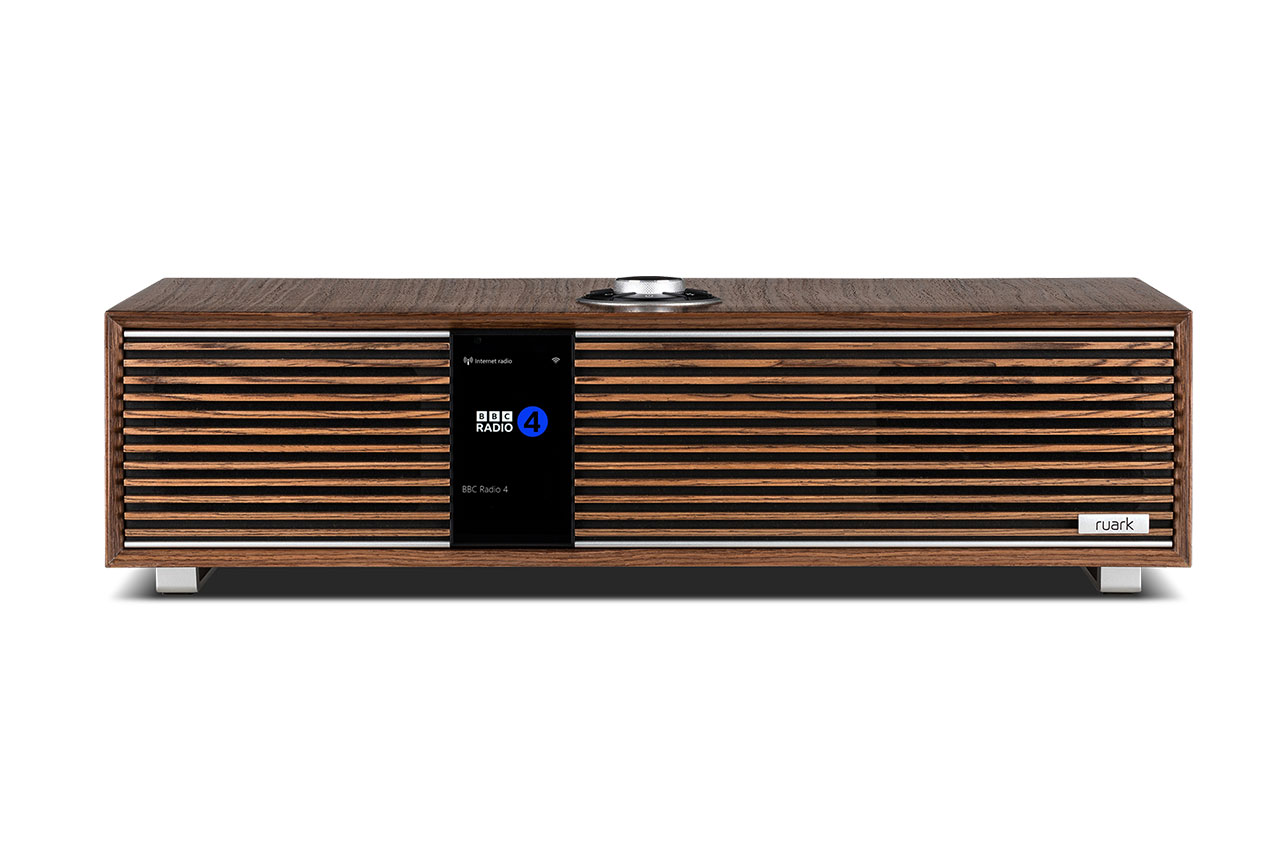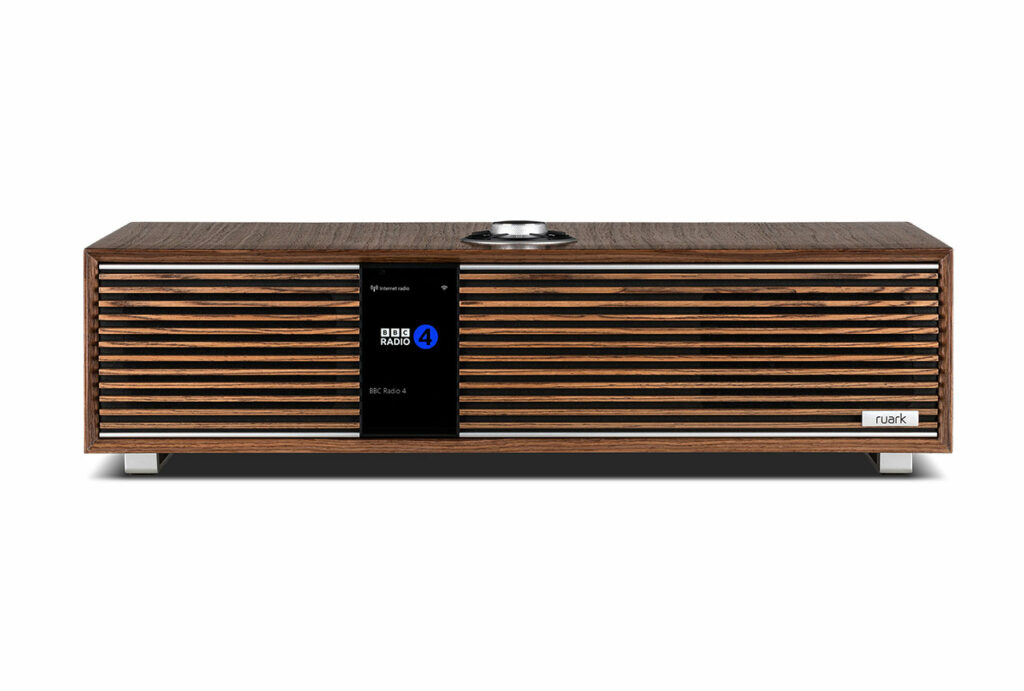We put the Ruark Audio R410 through our rigorous DXOMARK Audio test suite to measure its performance at playing back audio. In this review, we will break down how it fared in a variety of tests and several common use cases.
Overview
Key specifications include:
- Wireless protocols: AirPlay
- Wired connectivity: HDMI (eARC); RCA; Optical
- Height: 13.3 cm. Width: 56.0 cm. Depth: 29.0 cm
- Weight: 9500.0 g
- Speakers: Frequency response: 35Hz – 22kHz
Speaker units:
2 × Ruark 20mm silk dome tweeters,
2 × Ruark 100mm NS+ bass-mid units
Amplifier: 120W RMS Class D amplifier (0.02% THD @ 30W/CH)
Enhancements:
Adjustable bass and treble settings
Stereo+ 3D audio enhancement
Adaptive EQ provides ideal sound according to volume
Cabinet type: Tuned dual bass reflex enclosure
Test conditions:
- Tested with iPhone SE
- Communication protocol used: AirPlay
 Ruark Audio R410
Ruark Audio R410


Pros
- Wide stereo image
- Solid low end
- Very good dynamics performance at nominal and soft volumes
Cons
- Excessive treble can sound harsh or sibilant
- Poor artifacts performance, and multiple bugs
- Lack of consistency across different volumes
The Ruark Audio R410 speaker is an integrated music system that performed generally well in our wireless speaker test, particularly in challenging acoustics.
The speaker, with its wood-style finish that gives it a classic look, performed best in our relaxing use case, when music or other content is played at nominal and soft volumes, and it did so with a pleasantly wide stereo sound. When set to high volume, such as in a party use case, the speaker displayed a great loudness, but it struggled to keep a consistent quality across different tracks, especially when compared to the performance at lower volumes.
The R410 had a fair share of artifacts, particularly compression — and not only at maximum volume. In addition, setting up and connecting the speaker presented some quirks, which sometimes required a reset.
Listen to the tested speaker’s playback performance in this comparison with its competitors:
Test summary
About DXOMARK Wireless Speaker tests: For scoring and analysis in our wireless speaker reviews, DXOMARK engineers perform a variety of objective tests and undertake more than 20 hours of perceptual evaluation under controlled lab conditions. This article highlights the most important results of our testing. Note that we evaluate playback using only the device’s built-in hardware. (For more details about our Speaker protocol, click here.)
The following section gathers key elements of our exhaustive tests and analyses performed in DXOMARK laboratories. Detailed performance evaluations under the form of reports are available upon request. Do not hesitate to contact us.
The DXOMARK Speaker overall score is derived from a range of sub-scores. In this section, we will take a closer look at timbre, dynamics, spatial, volume, and artifacts, and explain what they mean for the user.

Timbre
Ruark Audio R410
152
DXOMARK timbre tests measure how well a speaker reproduces sound across the audible tonal range and takes into account bass, midrange, treble, tonal balance, and volume dependency.
The Ruark Audio R410’s timbre performance was decent overall, although tonal balance could be inaccurate, with a prominent upper treble throughout the tested use cases and minimal midrange in general. The exaggerated presence of upper treble is visible on the frequency response graph below, specifically between 9kHz and 14kHz. As a result, tonal balance sounded very bright but not very natural, and it could sound quite harsh in some cases, leading to an unpleasant listening experience.
When playing podcasts or watching movies, male voices tended to come out well, with a good amount of body. In particular, the excess treble really stood out in noisy environments. With female voices, however, sibilance tended to be exacerbated and resulted in a harsh playback rendition.
In comparison to the overwhelming upper treble presence, midrange generally sounded a bit hollow. However, bass sounded good and especially deep, thanks to a satisfying low-end extension.
The Ruark R410’s performance was great in challenging acoustics, such as reverberant rooms, as bass didn’t get too boomy or imprecise. In high-volume use cases such as Party, the low-end lost some presence in its upper region. While still deep, bass became a little bland in these cases.
The speaker is quite directional. However, when listening to the device from a side angle, timbre was still satisfying; the treble, which was a bit exaggerated, is arguably more tolerable.

Dynamics
Ruark Audio R410
137
Our dynamics tests measure how well a device reproduces the energy level of a sound source, taking into account attack, bass precision, and punch.
The R410 offered a strong dynamics performance, except at higher volumes. Attack was quite sharp in most use cases, and sounded snappy. The speaker delivered good bass precision, which was particularly impressive in the bathroom use case, which tends to be unforgiving for the low-end.
The sound envelope was accurate for most content. The speaker delivered a very satisfying punch, despite lacking some low-midrange energy.
At high volume, such as in the party use case, the performance was much less satisfying. Attack became severely hindered by compression, while envelope in the low end became imprecise. Punch was also lackluster in these use cases.

Spatial
Ruark Audio R410
111
Our spatial tests measure a speaker’s ability to reproduce stereo sound in all directions, taking into account localizability, balance, wideness, distance, and directivity. Please note that wideness is 0 on mono speakers and on speakers that cannot deliver a significant stereo effect.
The Ruark, from both its design and its processing, offers a very wide and satisfying stereo image. Localizability was generally very good. Distance was mostly accurate, and realistic, but performance tended to be impaired by either the exacerbated sibilants, making vocal content sound too close, or by the insufficient low midrange, which made content too distant perceptually. These drawbacks were generally minor.

Volume
Ruark Audio R410
141
Our volume tests measure both the maximum loudness a speaker is able to produce and how smoothly volume increases and decreases based on user input.
The speaker showed good volume performance, with volume-step distribution being very consistent and smooth. Loudness at maximum volume was excellent, but inconsistent, especially when it came to dynamics. At the other end, minimum volume was also hit by a higher noise floor in Bluetooth due to a constant background noise. The noise was not present when using other communication protocols.
Here are a few sound pressure levels (SPL) we measured when playing our sample recordings of hip-hop and classical music at maximum volume:
| Correlated Pink Noise | Uncorrelated Pink Noise | Hip-Hop | Classical | Latin | Asian Pop | |
| Ruark Audio R410 | 96 dBA | 97.9 dBA | 94.8 dBA | 88 dBA | 97.4 dBA | 88.3 dBA |
| JBL L75ms Music System | 91 dBA | 94.1 dBA | 93.3 dBA | 91.5 dBA | 91.3 dBA | 91.5 dBA |
| Bowers & Wilkins Formation Wedge | 90.4 dBA | 87.4 dBA | 89.1 dBA | 81 dBA | 90.2 dBA | 83 dBA |

Artifacts
Ruark Audio R410
133
Our artifacts tests measure how much source audio is distorted when played back, along with such other sound artifacts as noise, pumping effects, and clipping. Distortion and other artifacts can occur both because of sound processing and because of the quality of the speakers.
Artifacts performance was below average. During the evaluation, the audio stopped working a couple of times in AirPlay, and the speaker had to be reset to factory settings. The Wi-Fi setup was often buggy. In Bluetooth, a constant humming noise was present even though nothing was playing. The noise is pretty loud, which is not acceptable. At high volume, compression is noticeable, and bass hits are distorted.


